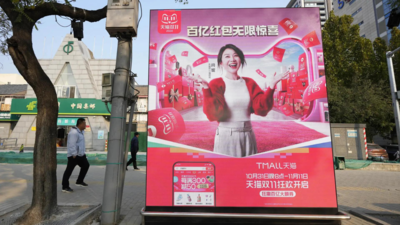
Pedestrians walk near an advertisement promoting the sales festival in Beijing. (Picture credit: AP)
While the Western world is gearing up for
Black Friday
and
Cyber Monday
, China has already celebrated its biggest shopping extravaganza—Singles Day. Often overshadowing other global shopping events,
Singles Day
has grown from a niche celebration to a
retail phenomenon
, surpassing the likes of Prime Day and Black Friday.
Originating as a light-hearted holiday to honour singlehood, it has evolved into a massive online shopping festival. This year, the event began on October 14 and culminated on November 11, marking the longest Singles Day sales period ever.
The concept of Singles Day traces back to 1993 when it was first celebrated at China's Nanjing University, initially dubbed "Bachelor's Day."
On this day, single individuals would treat themselves to gifts, often accompanied by social gatherings. What started as a modest celebration has transformed into a retail juggernaut, attracting millions of shoppers eager to grab deals.
The event's popularity soared after
Alibaba
, China's e-commerce giant, adopted it in 2009, turning November 11, or "11.11," into a day synonymous with discounts and deals. Over the years, other major platforms like JD.com and Pinduoduo joined the bandwagon, transforming Singles Day into a country-wide shopping spree.
Last year's Singles Day saw Chinese consumers spending a staggering 1.14 trillion yuan ($156.4 billion), according to Syntun data, reported by the news agency Reuters. This figure dwarfs the $38 billion spent during the US's Cyber Week, which includes Black Friday and Cyber Monday.
However, despite the impressive numbers, growth has been slowing down. The sales increase last year was just 2 per cent, the slowest in its history, reflecting changing consumer behaviours and market saturation.
Analysts suggest that this year's sales could reach an estimated 1.2 trillion yuan ($167 billion), reflecting a potential 15 per cent rise. However, experts remain cautious, noting that the increase may come with caveats as many shoppers bulk-buy to hit discount thresholds, often leading to returns, which can erode profits.
In recent years, Singles Day has seen a shift in
consumer spending patterns
. While previous years featured splurges on luxury goods and big-ticket items, last year saw a trend towards necessities like tissues, handwash, and pet food as shoppers turned frugal.
This shift could be attributed to
economic uncertainty
and the lingering effects of China's stringent Covid-19 measures. For 2024, household appliances have gained traction, partly driven by a 150 billion yuan trade-in subsidy scheme introduced by the Chinese government to spur consumption.
The landscape of Singles Day is also changing, with competition intensifying among e-commerce giants. While Alibaba remains a key player, JD.com and other platforms have gained significant ground.
The Singles Day frenzy comes at a crucial time for China, which is grappling with sluggish domestic consumption despite recent measures from Beijing aimed at boosting spending.
The government has rolled out aggressive policies, including key rate cuts and easing debt limits for local governments, hoping to spark a consumption-driven recovery. However, experts believe a full return to pre-pandemic growth levels may require more substantial fiscal intervention.
As the longest Singles Day ever comes to a close, all eyes are on the final sales figures, which Alibaba and JD.com have chosen not to disclose for a second consecutive year.
Despite the challenges, Singles Day continues to be an indicator of China's retail health, reflecting the delicate balance between discount-driven sales and the pursuit of sustainable profit margins.

 1 month ago
8
1 month ago
8










 English (US) ·
English (US) ·